|
James Bond is unique - or is he? Prior to his re-launch in
the 2006 film version of Casino Royale, audiences had
to accept that 007 had been portrayed by five different actors
in EON Productions' official series of James Bond movies.
But how could one agent have remained in active service for
40 years? Richard McGinlay has been assigned to find out...
Plausibility
has never been a major characteristic of the Bond movies,
but it does seem a bit much to be expected to believe that
every film between Dr.
No and Die
Another Day concerned just one man. If we are
to assume that the same agent is depicted in each and every
one of these movies, then we must also accept that by the
time of Die Another Day Bond must be at least 70 years
old!
It
is not possible to argue that the films take place over a
period of significantly less than four decades, because they
contain so many contemporary elements - such as technologies,
cars, fashions, and the years of Bond's favourite Dom Pérignon
- all of which date them considerably.
So,
do we instead assume that the initial phase of Bond-movie
continuity only extends so far (say, to the end of Roger Moore's
tenure) and that subsequent films (say, the Timothy Dalton
and Pierce Brosnan ones) are part of some other continuity
(like the infinite Earths occupied by DC Comics' superheroes)?
Or do we begin to wonder whether the agent known as James
Bond might not always have been the same man? There is a degree
of circumstantial evidence which suggests that "James Bond"
is an identity that has been assumed by a number of different
operatives.
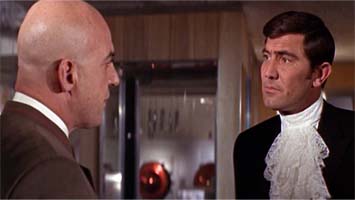 |
In
On Her Majesty's Secret Service,
Ernst Stavro Blofeld (Telly Savalas) fails to recognise Bond
(George Lazenby) through his basic "Clark Kent" disguise of
glasses and an altered voice. This was not a problem in the
original Ian Fleming novel, because it was the first time
that the two characters had met face to face on the printed
page. However, in the movie series they had already met in
You Only Live Twice.
(Incidentally, Blofeld's changing appearance could be explained
by plastic surgery, which he certainly makes use of in Fleming's
books, and would also tie in with the plastic surgeon he employs
in Diamonds
Are Forever.)
Following
the murder of Tracy (Teresa) Bond (Diana Rigg) in OHMSS,
we see 007 (Sean Connery) going after Blofeld (Charles Gray)
at the beginning of Diamonds Are Forever. However,
Bond's ruthless yet light-hearted attitude and his parting
quip, "Welcome to hell, Blofeld," are at odds with the bereaved
007 shown at the end of OHMSS. Can it be that the Lazenby
and Connery Bonds are indeed different agents?
M's
(Bernard Lee) comment in Diamonds Are Forever, "May
I remind you, 007, that Blofeld's dead. Finished! The least
we can expect from you now is a little plain, solid work,"
would seem incredibly insensitive if he were addressing the
same agent who had recently lost his wife. The same goes for
Moneypenny's (Lois Maxwell) request that Bond bring her back
an engagement ring from Amsterdam.
Is it therefore possible that Lazenby's Bond was recruited
to replace the retiring Connery Bond, in order to trick the
enemies of the British Secret Service into thinking that its
best agent was still active? Curiously, this very idea was
used in the plot to the 1967 spoof version of Casino Royale,
even before George Lazenby had been cast in OHMSS!
Perhaps Blofeld (and any other old adversaries who happen
to meet a new Bond) assumes that 007 has had plastic surgery
as part of his cover. Maybe the death of Tracy drives Lazenby's
Bond to suicide or a nervous breakdown following OHMSS,
and so Connery's Bond is persuaded to return briefly to service.
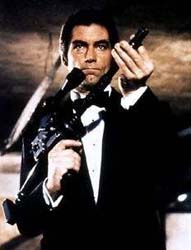 |
In
The Living Daylights,
when Bond (Dalton) asks Saunders (Thomas Wheatley) why the
defector Koskov (Jeroen Krabbé) asked for him as the marksman
to protect him, Saunders' sardonic reply is: "He's under the
impression you're the best." Could this be more than just
a snide comment, but rather an indication that Dalton's Bond
is in fact relatively new to the job and is riding on the
reputation of his predecessor(s)?
GoldenEye
features a radio telescope hidden in a lake, which is more
than a little reminiscent of the concealed volcano base in
You Only Live Twice. Yet Bond (Brosnan) does not seem
to notice the similarity. Could this mean that he is not the
same agent who was active during You Only Live Twice?
On a similar note, Brosnan's Bond cannot decipher the symbols
on a Chinese keyboard in Tomorrow
Never Dies, even though Connery's Bond boasted
that he "took a first in Oriental languages at Cambridge".
GoldenEye
introduces us to a new M (Judi Dench). By implication, we
are also introduced to the notion that there may have been
more than one M before her (as played by Bernard Lee and Robert
Brown) within EON's Bond movie series. (In fact, the non-EON-produced
Never Say Never Again established this concept much
earlier, when Edward Fox's M referred to his "illustrious
predecessor".)
This
all adds weight to the idea that "James Bond" is merely a
code identity that a succession of agents of a certain temperament
and ability have been assigned to operate under. In light
of this, M's promotion of Daniel Craig's Bond to Double-0
status in 2006's Casino Royale could be interpreted
as not simply a rebooting of the movie franchise but the initiation
of the latest in a long line of agents to operate under the
code name of James Bond.
A
similar process might be applied to the different actors who
have played Bond's equivalent in the CIA, Felix Leiter, and
even Miss Moneypenny. The appearance of John Terry as Felix
Leiter in The Living Daylights, which occurs between
David Hedison's roles in Live
and Let Die and Licence
to Kill could indicate that Terry's Leiter
was a temporary replacement for Hedison's. Alternatively,
it might mean the events of Licence take place before
those of Daylights.
The
activations and departures of the numerous Bonds could have
happened thus: Connery's Bond retires after You Only Live
Twice, but is briefly brought back into service for Diamonds
Are Forever, after which he retires or is killed in action.
Lazenby's Bond is driven to suicide or a nervous breakdown
that leads to an early retirement following his wife's death.
Moore's Bond retires or is killed in action following A
View to a Kill. Having continually defied M's
orders, Dalton's Bond is dismissed for insubordination or
resigns after his two missions. The "NINE YEARS LATER" caption
following the opening titles of GoldenEye could simply
indicate that the majority of the movie is set nine years
after the Dalton films. Brosnan's Bond retires or dies some
day after Die Another Day.
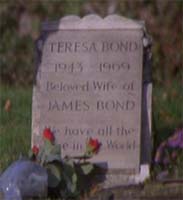 |
References
back to movies starring other lead actors are rare in the
Bond series, though the allusions to the death of Tracy Bond
in The
Spy Who Loved Me, For
Your Eyes Only and Licence to Kill do
pose a slight problem. The instance in The Spy Who Loved
Me could merely be a case of 007 (Moore) confirming his
official identity to the Russian agent Anya Amasova (Barbara
Bach). His visit to Tracy's grave at the beginning of For
Your Eyes Only might similarly be for the purpose of backing
up his cover story. Alternatively, his apparently genuine
remorse could indicate that it is also the (unmarked) grave
of the Lazenby Bond, who might have been a colleague and friend
of Moore's Bond. The reference in Licence to Kill to
Bond (Dalton) having been married before could refer to another
woman.
The
only other direct cross-references to the adventures of a
previous Bond are in OHMSS, in which Lazenby's 007
examines souvenirs from Sean Connery's tenure. However, he
might have just inherited these from his predecessor.
There
is another possible explanation, though...
If
you're a fan of Doctor Who, then Bond's changing appearance
and ageless longevity could be reconciled along with the above
continuity references if you assume that 007 is a Time Lord!
I'm not the first to propose this outlandish mythology-crossing
theory. There's an intriguing web-based round-robin crossover
story entitled From UNIT With Love, which documents
an adventure shared by the Third Doctor and Brosnan's Bond,
while the Doctor Who novel Bullet
Time by David A. McIntee briefly mentions "MI6's
Time Lord".
It
is true that GoldenEye makes reference to Bond's parents,
but this needn't rule out the possibility that 007 is a Gallifreyan.
The story regarding his parentage might be an official fabrication;
his parents could have been Time Lords living on Earth; or
maybe, like the Doctor, Bond is half-human.
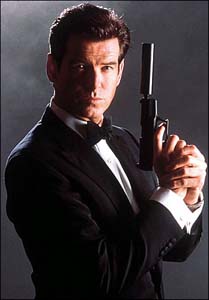 |
As
with the numerous incarnations of the Doctor, the various Bonds
have all exhibited certain key characteristics - in Bond's case,
being an exceptional agent and a ladies' man, with a taste for
the finer things in life - but with subtle variations. The first
Bond we meet (Connery) is relatively callous: all of his successors
are sensitive and compassionate by comparison. The next Bond
(Lazenby) is prone to insubordination. The third Bond that we
meet (Moore) is the most humorous to date. His successor (Dalton)
has as hard an edge as his 1962-1971 persona, but is even more
prone to insubordination than his 1969 self. The next Bond (Brosnan)
combines the sensitivity of his three immediate predecessors
with the humour of his 1973-1985 incarnation, but with a harder
edge. The current status of Brosnan's incarnation is unknown.
I'll come to Daniel Craig's Bond in a moment...
Bond's hazardous lifestyle could have given him ample need
to regenerate from time to time. The short-lived tenure of
the Lazenby incarnation could be attributed to an attempted
suicide following his wife's murder, or a nervous breakdown
that triggered a regeneration. Dalton's Bond chafed against
regulations and orders during both of his movies, so perhaps
he decided to become a free agent (excuse the pun) and left
the Earth in his TARDIS for an extended period of relative
time, only returning to duty after his regeneration into the
Brosnan incarnation. (In case you're wondering, Bond probably
doesn't use his TARDIS during missions for MI6 in order to
prevent it from falling into enemy hands.)
The
presence of Connery's Bond in Diamonds Are Forever
could also be explained by TARDIS travel. Perhaps Bond, just
like the Doctor during his final years as UNIT's scientific
adviser, often departs on trips of his own. A slight miscalculation
might have caused the Connery Bond to return to Earth a little
ahead of his time. Nevertheless he is needed by MI6 to pursue
Blofeld and to investigate a smuggling case, perhaps because
Moore's Bond is away on assignment elsewhere or off on travels
of his own. M is careful not to reveal the events of OHMSS
to this earlier Bond, since they haven't happened to him yet.
(Alternatively, perhaps Diamonds simply takes place
before OHMSS for all the characters concerned.)
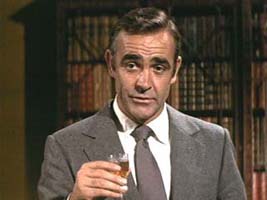 |
Bond's
failure to notice the similarity between the hidden radio
telescope in GoldenEye and the volcano base in You
Only Live Twice (mentioned earlier in this feature to
demonstrate that the various Bonds might be different agents)
could indicate a lapse of memory on the part of the Time Lord.
After all, far more than 30 years might have elapsed for Bond,
given the possibility of him taking extended trips in his
TARDIS between cases.
His
failure to comprehend the Chinese keyboard in Tomorrow
Never Dies could suggest that 007 was boasting when he
claimed to have taken a first in Oriental languages. After
all, Time Lords (via their TARDISes' telepathic circuits)
seem to possess the ability to understand most spoken languages
anyway. Thus Bond is a very cunning linguist, but cannot always
interpret written languages.
Daniel
Craig's 007 could be regarded as occupying a separate continuity
than the Bond films that preceded him - or he might actually
be an earlier incarnation than Connery's Bond, displaced in
time. Perhaps M, prior to the events of Casino Royale,
is reluctantly forced to promote the newly arrived blond Bond
for fear of damaging the timeline if she does not. Maybe she
knows (from secret files or from conversations with Brosnan's
Bond) that back in the 1960s the Time Lord arrived at MI6
having already gained Double-0 status (with papers to prove
it) in Earth's future. M's hostility towards this still rough-around-the-edges
incarnation could be an expression of her annoyance at having
her actions (the promotion of Bond) determined by causality
rather than her own free will. The death of Bond's lover,
Vesper Lynd (Eva Green) could be one of the factors that leads
to Connery's Bond being so cold-hearted and callous.
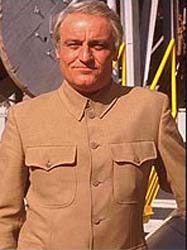 |
If
we buy into the Time Lord theory, then other characters, such
as Leiter, Moneypenny and Blofeld, might be Gallifreyans as
well. Just as the second incarnation of Romana (Lalla Ward)
based her appearance on Princess Astra of Atrios, we see evidence
that Charles Gray's Blofeld modelled himself upon the likeness
of Henderson in You Only Live Twice!
As
with Bond's potentially time-displaced appearances in Diamonds
Are Forever and Casino Royale, time travel could
also explain the presence of John Terry's Felix Leiter in
The Living Daylights, in between David Hedison's appearances
in Live and Let Die and Licence to Kill. I would
theorise that it is the John Terry incarnation who is "out
of sequence", visiting his own future, so to speak. The fact
that Bond (Dalton) momentarily believes that Felix is dead
in Licence to Kill suggests that the Hedison incarnation
is Felix's latest form at the time. Alternatively, as suggested
earlier, perhaps Licence takes place before Daylights
for all concerned.
Just
in case this feature isn't silly enough already, I will leave
you with some ideas for future "Bond as a Time Lord" films:
-
Dr. Who (featuring a guest appearance by another
famous Time Lord)
From Ruta With Love (in which the Rutans set a trap
for Bond)
Goldplunger (in which Bond takes on the Emperor Dalek)
You Only Live Thirteen Times (in which Blofeld, who
has used up all of his regenerations, attempts to steal
Bond's remaining lives)
Kontron Crystals Are Forever (in which Bond smashes
a smuggling operation by the Borad)- The
Man with the Glittergun
(featuring the Cybermen)
- The
I Who Loved Me (in
which Bond has to team up with a member of the I from Seeing
I)
- For
Your Eye-stalk Only
(in which Bond must recover an advanced attack system from
a sunken Dalek ship)
- A
View to a Krill
(in which killer fish attack Silicon Valley)
- Golden
I (featuring
the return of the I)
- Regenerate
Another Day
(in which Bond tackles a villain who can alter his physical
appearance)
Kassia
Royale (in which a Traken consul wins royal status at
a French gaming table)
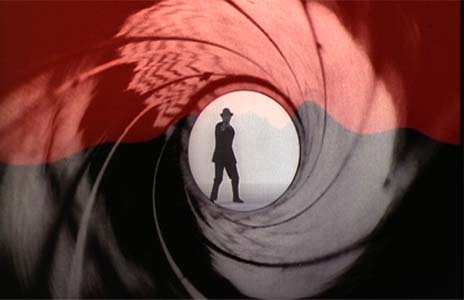
Return
to...

|